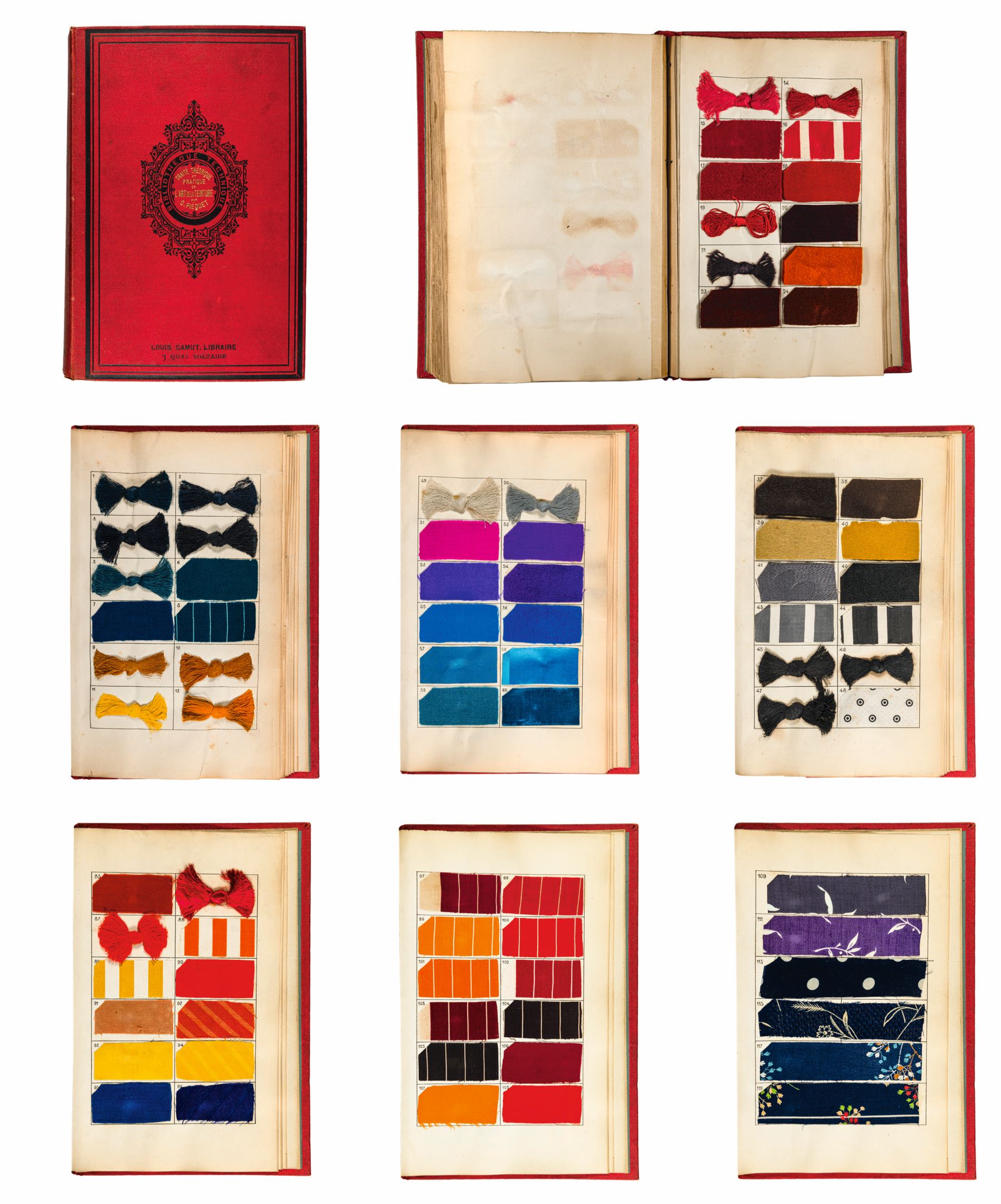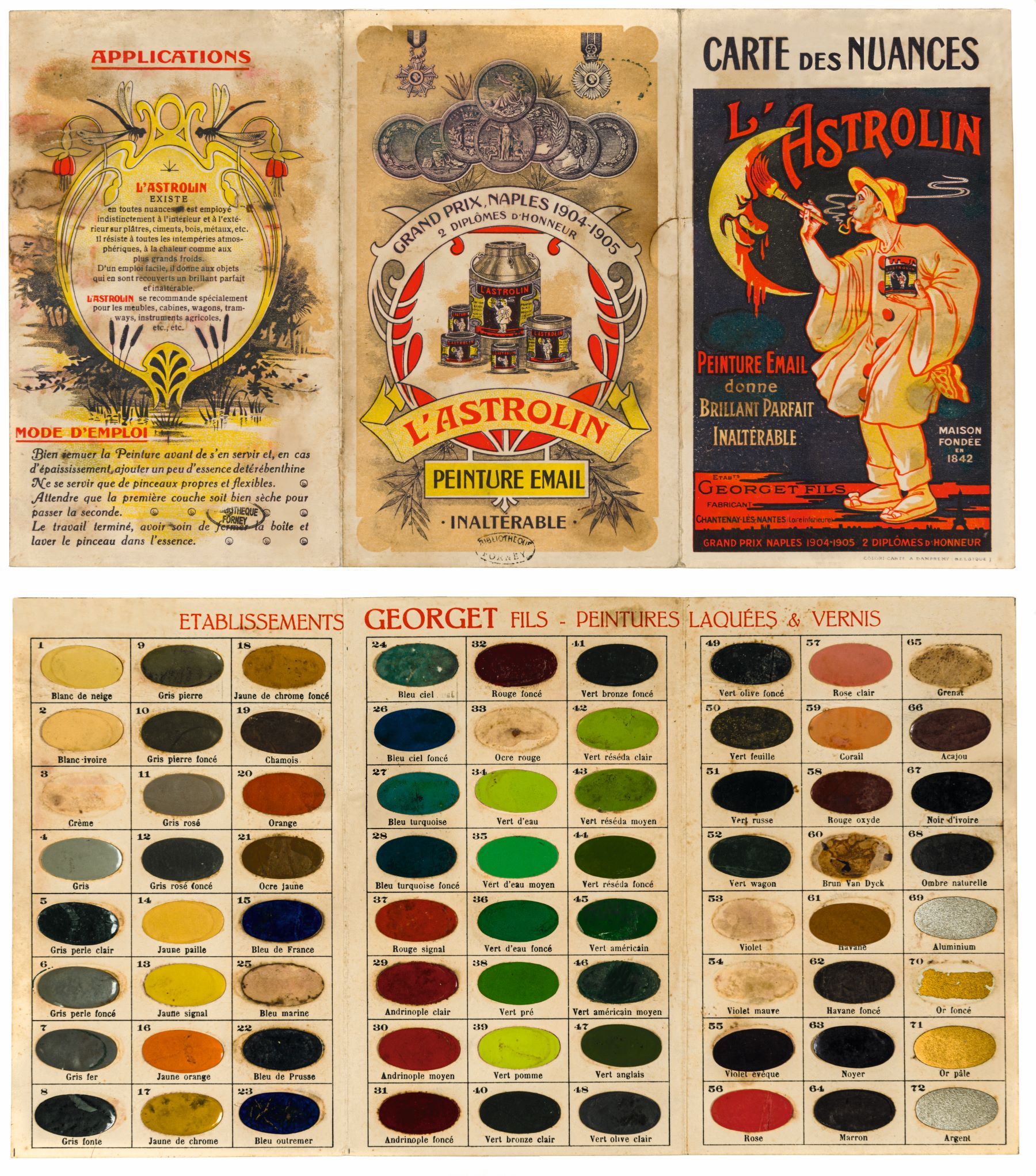
Color chart from The Chemistry of Dyers, New Theoretical and Practical Treatise on the Art of Dyeing and Printing Fabrics (courtesy of the Okhra-Ecomuseum of Ocher, Roussillon)
Artists select their palettes ever so carefully, but an old piece of parchment with all the colors, circled in a wheel or disciplined into a grid, their names inked gracefully beneath them? I can pore over those antique charts for hours. Seeing the colors ranged next to one another, like somebody pinned a rainbow to paper, gives a sense of completion—and infinite possibility.
Such charts whisper seduction, and the luxurious agony of choosing. They come from a time when, if you had money, the entire spectrum of dyed silk unfolded before you. The hue and shade you chose would be exactly what you received: you were picking from bundles of thread that showed lighter and darker versions as the light hit, or from mouchets, tufts of fabric, that were tied in bows, fanned out, or twisted into rosettes and glued to the chart. No four-color process printing would distort the result; no computer monitor would steal its refinement. Nor would chemistry mock the color’s name, mixing molecules to create an “indigo” that never saw an indigo plant.
In the first charts, colors came from nature and stayed true to nature. And oh, the uses they found. In Color Charts: A History, anthropologist Anne Varichon shows us a beautiful but practical thirteenth-century Rotae Urinarum, a wheel identifying the various colors of urine to aid in diagnosis. By the Renaissance, color was more art than science. Painting had become a pastime for the wealthy, who could afford to import lapis lazuli for blue pigment or malachite for green and pay Venetian colormakers to add ground glass for brilliance.
In the seventeenth century, science organized itself into a discipline based on experimentation and measured, published results. Color was researched and theorized. Naturalists used charts to make their taxonomic descriptions as accurate as possible, so everyone could agree that a bird had carmine wings and a Negrus throat.
The association with animals endured. In 1814, Patrick Syme created a chart with descriptions of snow white as “breast of black-headed gull”; reddish white as “egg of grey linnet”’; skimmed milk white as “the white of the human eyeballs.” He also listed vegetable references: bluish green was not only the egg of a thrush but “the under disk of wild rose leaves.”
Dyeing—stealing color from nature—was a growing practice, but still just for textiles. Jean Girardin, an industrial chemist in Rouen, was appalled by the hunger for personal color “among the most barbaric peoples….savages rub their bodies with colored earth or plant juices; they dye their hair, color their teeth….” It would not take long for “barbarism” to saturate the sophisticated West.
In the middle of the nineteenth century, the first synthetic dye, mauveine, was produced from coal tar. This must have seemed like progress. But “the arrival of synthetic color,” Varichon writes ruefully, “led to the disappearance of the rich chromatic variations nature-based dyes provided.”
Her book tells the story of an explosion, then a distortion and loss, of color, a rising falsification and limitation after the first exuberant discoveries. The chemists’ colors “initiated the silent but irreversible process of wiping out the vast body of knowledge and skill regarding color that nonindustrial cultures had developed over centuries.”

Astrolin Color Card, 1906 (courtesy of the Bibliotheque Forney, Paris)
Still, the infinite variety of attainable hues made color charts more important than ever. They could help determine the ripeness of an apricot, what shade of enamel a replacement tooth should be, or whether veal had been milk-fed or grass-fed (with plastisols to give the chart swatches the sheen and coolish texture of raw meat). In 1899, in a last grab at verisimilitude, Henri Dauthenay accepted an assignment to catalog all chrysanthemum colors. For Pure White, he left the space blank. For bluish green, tone 1, he described “the color of an artichoke leaf seen from a man’s height, about one meter away from the feet, with diffuse light (observation made during summer).”
Over the next century, that sort of natural reference would atrophy, and a more sinister use would emerge. Late nineteenth-century color charts made hierarchical arrangements of different races’ complexions, paving the way for the Nazis’ racial classification system.
At the same time—for what is social history without paradox?—access to color was being democratized. Color charts had made their way into haberdasheries, hardware stores, and the dazzling Victorian retail palaces. No longer were color options only available to chemists and manufacturers. Anyone could see them, realize their range, be excited by their possibilities. And because the colors were given poetic names, Varichon writes, “the color chart appealed to the imagination both visually and culturally. It embodied the color revolution. Color began to be an aspiration of an entire civilization.”
Distinguishing among thousands of colors by name trained the eye of the consumer, she adds. People were not yet indulging in color therapy or having their colors done or asking what “season” they were. But they did see color as a form of self-expression, now that it was available to them in various hues of lipstick, stockings, leather, cars. By the end of World War I, “the most beautiful and most stable colors were no longer reserved for the elite.” Color charts had “stimulated an appetite for color, legitimized it, and satisfied it. Color was becoming a right.”
Just as we reached for its glories, it lost both its authenticity and its poetry.
By the 1960s, chemists were printing humorless, uber-technical charts, while cosmetics manufacturers tagged colors with fanciful exaggerations that ignored nature and manipulated vanity. Two trends now grew apace: color as self-expression and color as deception. Accused of decimating populations of hummingbirds, marabous, and egrets, haute couture started dyeing rooster feathers to look like birds of paradise. Metallic powders took hold, suggesting an impossible sheen.
The French named their color charts nuances, but the new charts failed to capture subtleties. By the 2000s, Varichon notes, “the color chart has gradually been emptied of the substance that created it.” We must take home snippets of the fabric, paint blotches on our walls, order and mail back our clothes, because we can never be sure what color we are really choosing. We pore over the swatches and charts for hours, deliberating, then begin to wonder, the minute we have chosen, whether our eyes have been deceived.
The evolution of color names should have warned us. In fourteenth-century Europe, woolen fabrics were named blood, peony, columbine, peach blossom, marigold, saffron, lion fur, meadow green, sky blue, and donkey-back gray. By the turn of the nineteenth century, the names for silk ribbon colors were drawn from horse racing (auteuil, for a famous racecourse, and jockey club), travel (Nile, Russian, Sailor, Antilles, Geisha, Talisman, Troika), and opera (Fortunio, Mephisto). In 1939, the Societe Anonyme des Matieres Colorantes de Saint-Denis made charts of seasonal colors and their complements (foreshadowing our absurd Color of the Year trend forecasts) that included Orange Marmalade and Blue of Your Eyes. 1952, a Paris fabric wholesaler used floral names that included “dead rose” and drew from literature (Dante) and astronomy (Saturn).
We had moved beyond obvious nature references to the categories of our sensual imagination.
Today’s nail polishes are named $elf Made, Salty Sweet Nothings, Pants on Fire!, Correctamundo, Blame the Mistletoe, Not So Bora-Bora-ing Pink, and Bubble Bath. Paints are called Balboa Mist, New Hope Gray, Warm Comfort, Bistro Blue. It is fun, choosing your shade and announcing it to friends. But how are they to visualize this color? Where does it come from? Our sensual imagination has gone abstract, need-based, overclever, and devoid of substance.
The loss makes those antique color charts all the more precious. “Since its roots with the material have been broken,” Varichon writes, “all the power of color has found refuge and been concentrated in the image of the color chart.” A reminder of where color came from, and how pure and reliable it once was.
Read more by Jeannette Cooperman here.
